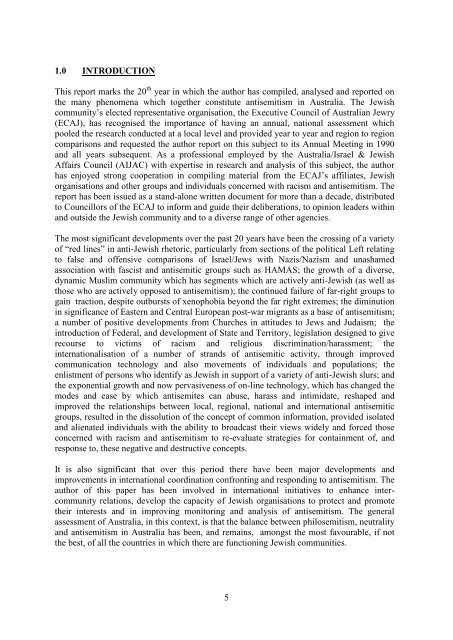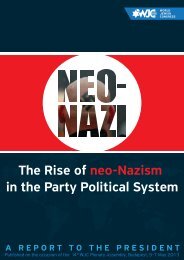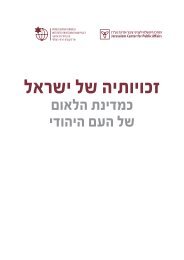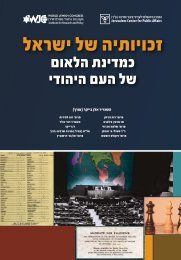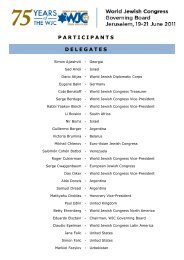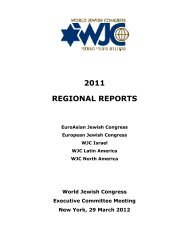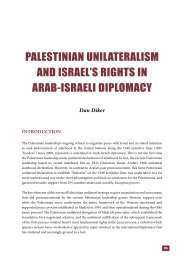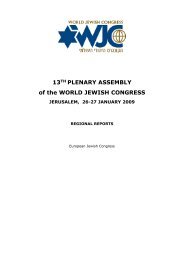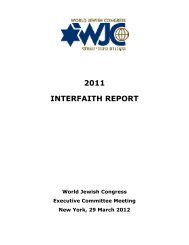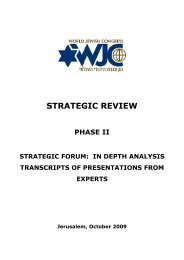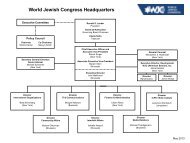Antisemitism Report 2009 - World Jewish Congress
Antisemitism Report 2009 - World Jewish Congress
Antisemitism Report 2009 - World Jewish Congress
You also want an ePaper? Increase the reach of your titles
YUMPU automatically turns print PDFs into web optimized ePapers that Google loves.
1.0 INTRODUCTION<br />
This report marks the 20 th year in which the author has compiled, analysed and reported on<br />
the many phenomena which together constitute antisemitism in Australia. The <strong>Jewish</strong><br />
community‘s elected representative organisation, the Executive Council of Australian Jewry<br />
(ECAJ), has recognised the importance of having an annual, national assessment which<br />
pooled the research conducted at a local level and provided year to year and region to region<br />
comparisons and requested the author report on this subject to its Annual Meeting in 1990<br />
and all years subsequent. As a professional employed by the Australia/Israel & <strong>Jewish</strong><br />
Affairs Council (AIJAC) with expertise in research and analysis of this subject, the author<br />
has enjoyed strong cooperation in compiling material from the ECAJ‘s affiliates, <strong>Jewish</strong><br />
organisations and other groups and individuals concerned with racism and antisemitism. The<br />
report has been issued as a stand-alone written document for more than a decade, distributed<br />
to Councillors of the ECAJ to inform and guide their deliberations, to opinion leaders within<br />
and outside the <strong>Jewish</strong> community and to a diverse range of other agencies.<br />
The most significant developments over the past 20 years have been the crossing of a variety<br />
of ―red lines‖ in anti-<strong>Jewish</strong> rhetoric, particularly from sections of the political Left relating<br />
to false and offensive comparisons of Israel/Jews with Nazis/Nazism and unashamed<br />
association with fascist and antisemitic groups such as HAMAS; the growth of a diverse,<br />
dynamic Muslim community which has segments which are actively anti-<strong>Jewish</strong> (as well as<br />
those who are actively opposed to antisemitism); the continued failure of far-right groups to<br />
gain traction, despite outbursts of xenophobia beyond the far right extremes; the diminution<br />
in significance of Eastern and Central European post-war migrants as a base of antisemitism;<br />
a number of positive developments from Churches in attitudes to Jews and Judaism; the<br />
introduction of Federal, and development of State and Territory, legislation designed to give<br />
recourse to victims of racism and religious discrimination/harassment; the<br />
internationalisation of a number of strands of antisemitic activity, through improved<br />
communication technology and also movements of individuals and populations; the<br />
enlistment of persons who identify as <strong>Jewish</strong> in support of a variety of anti-<strong>Jewish</strong> slurs; and<br />
the exponential growth and now pervasiveness of on-line technology, which has changed the<br />
modes and ease by which antisemites can abuse, harass and intimidate, reshaped and<br />
improved the relationships between local, regional, national and international antisemitic<br />
groups, resulted in the dissolution of the concept of common information, provided isolated<br />
and alienated individuals with the ability to broadcast their views widely and forced those<br />
concerned with racism and antisemitism to re-evaluate strategies for containment of, and<br />
response to, these negative and destructive concepts.<br />
It is also significant that over this period there have been major developments and<br />
improvements in international coordination confronting and responding to antisemitism. The<br />
author of this paper has been involved in international initiatives to enhance intercommunity<br />
relations, develop the capacity of <strong>Jewish</strong> organisations to protect and promote<br />
their interests and in improving monitoring and analysis of antisemitism. The general<br />
assessment of Australia, in this context, is that the balance between philosemitism, neutrality<br />
and antisemitism in Australia has been, and remains, amongst the most favourable, if not<br />
the best, of all the countries in which there are functioning <strong>Jewish</strong> communities.<br />
5


